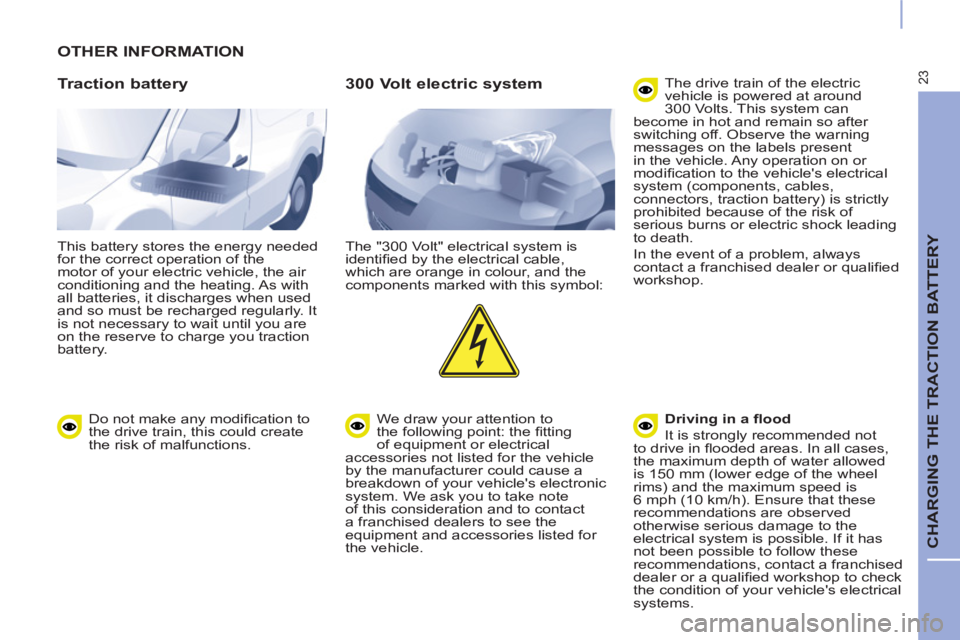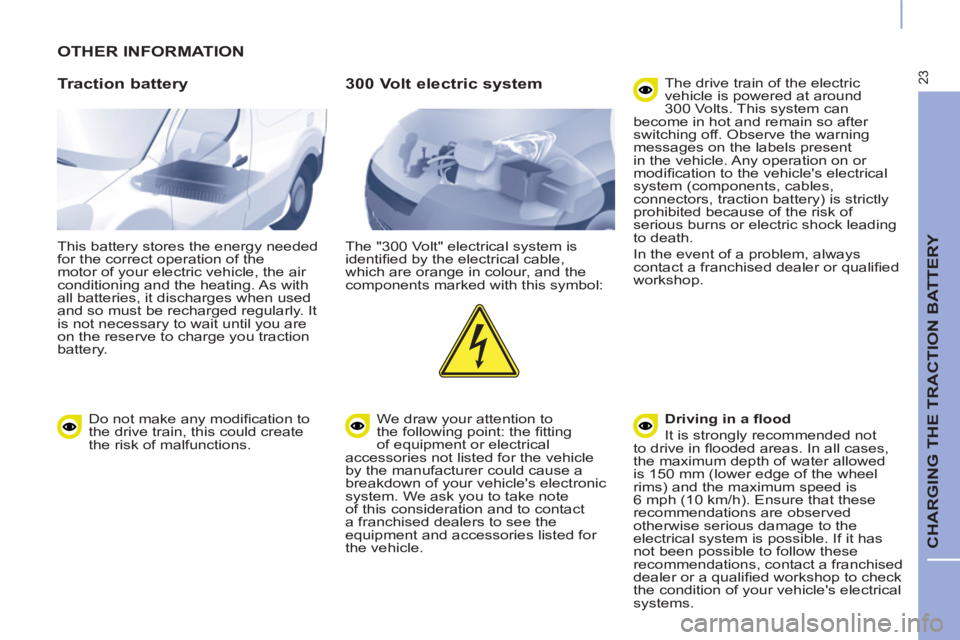Page 281 of 328

23
CHARGING THE TRACTION BATTERY
OTHER INFORMATION
Traction battery
This battery stores the energy needed
for the correct operation of the
motor of your electric vehicle, the air
conditioning and the heating. As with
all batteries, it discharges when used
and so must be recharged regularly. It
is not necessary to wait until you are
on the reserve to charge you traction
battery.
300 Volt electric system
The "300 Volt" electrical system is
identifi ed by the electrical cable,
which are orange in colour, and the
components marked with this symbol:
We draw your attention to
the following point: the fi tting
of equipment or electrical
accessories not listed for the vehicle
by the manufacturer could cause a
breakdown of your vehicle's electronic
system. We ask you to take note
of this consideration and to contact
a franchised dealers to see the
equipment and accessories listed for
the vehicle. The drive train of the electric
vehicle is powered at around
300 Volts. This system can
become in hot and remain so after
switching off. Observe the warning
messages on the labels present
in the vehicle. Any operation on or
modifi cation to the vehicle's electrical
system (components, cables,
connectors, traction battery) is strictly
prohibited because of the risk of
serious burns or electric shock leading
to death.
In the event of a problem, always
contact a franchised dealer or qualifi ed
workshop.
Driving in a fl ood
It is strongly recommended not
to drive in fl ooded areas. In all cases,
the maximum depth of water allowed
is 150 mm (lower edge of the wheel
rims) and the maximum speed is
6 mph (10 km/h). Ensure that these
recommendations are observed
otherwise serious damage to the
electrical system is possible. If it has
not been possible to follow these
recommendations, contact a franchised
dealer or a qualifi ed workshop to check
the condition of your vehicle's electrical
systems.
Do not make any modifi cation to
the drive train, this could create
the risk of malfunctions.
Page 288 of 328
30
TOWING THE VEHICLE
Front towing eye
The rear towing eye must not be used
for towing on the road. It can be used
to extract the vehicle when stuck, for
example. The towing eye is stowed in the tool
box under the right hand seat.
Towing the vehicle with the driving
wheels on the ground is prohibited.
When towing the vehicle with just two
wheels on the ground, use professional
lifting equipment.
Failure to do this may cause damage
to the braking components and the
electric motor.
Rear towing eye
Towing another
vehicle
Your vehicle cannot in any
circumstances be used to tow another
vehicle.
Page 290 of 328
32
IDENTIFICATION MARKINGS
A. Manufacturer's plate.
This is located on the right-hand
middle pillar.
1 - VF Type serial number.
2 - Gross vehicle weight (GVW).
3 - Gross train weight (GTW).
4.1 - Maximum weight on front axle.
4.2 - Maximum weight on rear axle.
B. Serial number.
This is engraved on the front right
wheelarch.
C. Tyres and paint colour
code.
The label C
, on the front door gives:
- the wheel and tyre sizes,
- the brands of tyres approved by the
manufacturer,
- the tyre pressures (the tyre
pressures must be checked when
the tyres are cold, at least once a
month),
- the paint colour code.
Page 305 of 328

11
INSTRUMENTS AND CONTROLS
Starting the vehicle
- To start the vehicle, the
drive selector must be in
position P
,
- press the brake pedal,
- torn the ignition key in the
switch.
STARTING PROCEDURE
This indicator lamp comes on
when the vehicle is ready to drive.
-
Press the brake pedal,
-
select R
or D
,
-
release the brake pedal and
press the accelerator pedal to
move off.
The selection appears in the current
energy consumption screen in the
instrument panel.
Drive selector
If the drive selector is not in position P
and/or if the brake pedal is not
pressed, The vehicle will not start.
Repeat the procedure for starting the
vehicle.
The selection of position D
or R
on
the drive selector determines the drive
direction. It is preferable to be at a
full stop before changing the drive
direction.
P
(Park). Parking. Move the
selector to position P
, there is
an audible signal.
N
(Neutral). Move the
selector to position N
, there is
an audible signal.
Do not select this position, even
momentarily, when the vehicle is
moving.
The vehicle is free-wheeling. Select D
to return to forward drive.
D
(Drive). Forward drive.
Move the selector to
position D
, there is an audible
signal.
It is recommended that you keep
your foot on the brake pedal when
selecting positions R
or D
.
R
(Reverse). Reverse
drive. Move the selector to
position R
, there is an audible
signal.
Only engage reverse when the
vehicle is immobilised.
When moving from position R
to
position P
, N
is displayed momentarily
in the instrument panel.
There is an audible signal when
changing drive position with the
selector.
The audible signal is deactivated if the
user has chosen to inhibit operation of
the "Rear parking sensors".
The driver must be particularly
vigilant when driving the electric
vehicle as it makes very little noise
when moving.
Ready
Parking the vehicle
When leaving the vehicle, it is strongly
recommended that you apply the parking
brake, place the drive selector in position P
then switch off the ignition.
There is an audible signal on opening the
driver's door if:
-
the ignition is still on (" Ready
" lamp on),
-
the vehicle has not been correctly
immobilised (drive selector not in
position P
).
An alert message is displayed in the screen.
Page 317 of 328

23
CHARGING THE TRACTION BATTERY
OTHER INFORMATION
Traction battery
This battery stores the energy needed
for the correct operation of the
motor of your electric vehicle, the air
conditioning and the heating. As with
all batteries, it discharges when used
and so must be recharged regularly. It
is not necessary to wait until you are
on the reserve to charge you traction
battery.
300 Volt electric system
The "300 Volt" electrical system is
identifi ed by the electrical cable,
which are orange in colour, and the
components marked with this symbol:
We draw your attention to
the following point: the fi tting
of equipment or electrical
accessories not listed for the vehicle
by the manufacturer could cause a
breakdown of your vehicle's electronic
system. We ask you to take note
of this consideration and to contact
a franchised dealers to see the
equipment and accessories listed for
the vehicle. The drive train of the electric
vehicle is powered at around
300 Volts. This system can
become in hot and remain so after
switching off. Observe the warning
messages on the labels present
in the vehicle. Any operation on or
modifi cation to the vehicle's electrical
system (components, cables,
connectors, traction battery) is strictly
prohibited because of the risk of
serious burns or electric shock leading
to death.
In the event of a problem, always
contact a franchised dealer or qualifi ed
workshop.
Driving in a fl ood
It is strongly recommended not
to drive in fl ooded areas. In all cases,
the maximum depth of water allowed
is 150 mm (lower edge of the wheel
rims) and the maximum speed is
6 mph (10 km/h). Ensure that these
recommendations are observed
otherwise serious damage to the
electrical system is possible. If it has
not been possible to follow these
recommendations, contact a franchised
dealer or a qualifi ed workshop to check
the condition of your vehicle's electrical
systems.
Do not make any modifi cation to
the drive train, this could create
the risk of malfunctions.
Page 324 of 328
30
TOWING THE VEHICLE
Front towing eye
The rear towing eye must not be used
for towing on the road. It can be used
to extract the vehicle when stuck, for
example. The towing eye is stowed in the tool
box under the right hand seat.
Towing the vehicle with the driving
wheels on the ground is prohibited.
When towing the vehicle with just two
wheels on the ground, use professional
lifting equipment.
Failure to do this may cause damage
to the braking components and the
electric motor.
Rear towing eye
Towing another
vehicle
Your vehicle cannot in any
circumstances be used to tow another
vehicle.
Page 326 of 328
32
IDENTIFICATION MARKINGS
A. Manufacturer's plate.
This is located on the right-hand
middle pillar.
1 - VF Type serial number.
2 - Gross vehicle weight (GVW).
3 - Gross train weight (GTW).
4.1 - Maximum weight on front axle.
4.2 - Maximum weight on rear axle.
B. Serial number.
This is engraved on the front right
wheelarch.
C. Tyres and paint colour
code.
The label C
, on the front door gives:
- the wheel and tyre sizes,
- the brands of tyres approved by the
manufacturer,
- the tyre pressures (the tyre
pressures must be checked when
the tyres are cold, at least once a
month),
- the paint colour code.